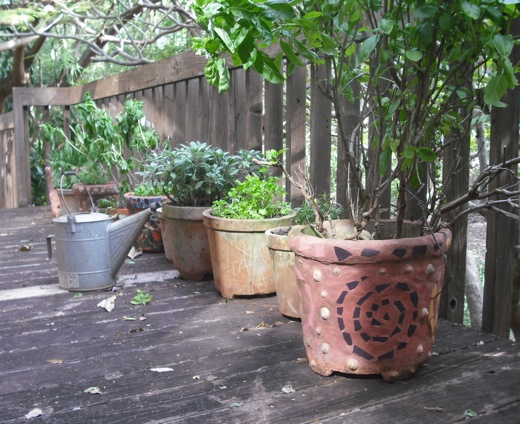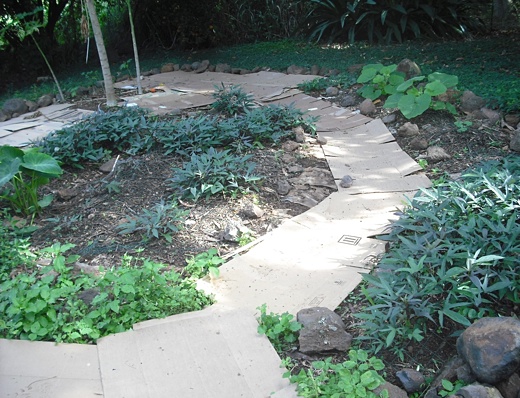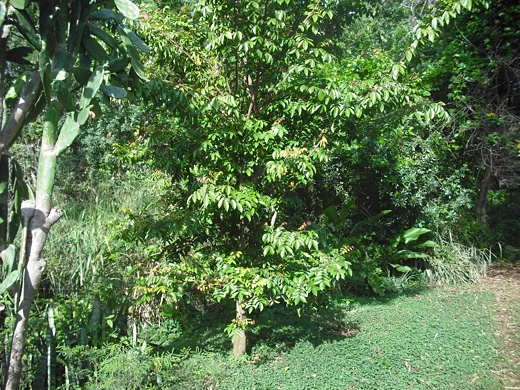SUBHEAD: Part 1 of a 6 part series on Permaculture Design Guidelines.
By Birgit Bradtke in Tropical Permaculture in 2010 -
(http://www.tropicalpermaculture.com/permaculture-zones.html)

Image above: Herb pots on deck outside of kitchen. All photos by Juan Wilson in Hanapepe Valley.
Permaculture zones save a lot of time and energy by reducing necessary travel. And that makes a huge difference, believe me. The planting zones in a permaculture design are numbered from the inside out. Zone 0 is the house. From here we count outwards. That gives the initial impression that permaculture zones are just concentric circles around your house, but as you will see, that's not the case...
Permaculture Zone 1
Zone 1 contains all the most visited areas of your garden. Usually it's the area closest to your house, but it also extends along frequently travelled paths. And if there is one side of your house that you rarely go to, then that's not part of growing zone 1, no matter how close to the house it is. Everything that needs a lot of attention should be growing in zone 1. Examples for plants to grow here are seedlings that require daily watering, frequently used herbs, salad vegetables, a lemon tree, and maybe your favorite flowers or scented shrubs. Something like the area where you collect compost may also be part of permaculture zone 1.
Let me show you with a few examples why it is important to place anything that needs a lot of attention in zone 1: Say you have chickens and you visit them daily to feed them and collect the eggs. A propagation area along the path would make sure you don't forget to water your precious seedlings.
Or say you only have a tiny yard and a busy corporate lifestyle. Place your seedlings so you fall over them when you walk from your car to your house, and you'll notice any problems before it's too late.
Or another example: you are throwing a dinner party, it's raining and you started cooking late, because as usual you were held up in the office. The guests have arrived, the soup is ready, and the fresh chives to add that extra zing are at the end of a muddy path right down the bottom of your garden. Are you going to venture out to get them? Herbs like parsley and chives should grow right on your doorstep, and you will actually use them. These are just a few examples, but I'm sure you get the drift. Forget that old fashioned idea that useful plants like herbs or vegetables should be separated from your "ornamental" garden and grown in a vegetable patch in a far corner of your yard. Especially for beginners that is the surest way to a neglected, overgrown, weedy, sorry excuse for a vegetable garden... Herbs and vegetables are very ornamental in their own right, some are outright spectacular. Just take plain lettuce.
Do you have any idea how many colourful varieties with different kinds of leaves there are? You can plant the most beautiful swirls and patterns just out of lettuce. If that pretty bed is next to your kitchen door it takes no time and effort at all to pick the outside leaves every day as required. For a spicier salad use purple mustard, and tatsoi, and, and... And who says you can't grow flowers amongst them? Nasturtiums add a cheerful splash of bright color, and you can eat the leaves and the flowers in salads. They taste and look good, like many, many other edible plants. It's time we give our herbs and vegetables the place they deserve, which mostly happens to be in permaculture zone 1.
Permaculture Zone 2
Image above: Sweet potatoes and squash growing in mulch bed.
Zone 2 in a permaculture design also receives a lot of attention, but less than zone 1. Growing zone 2 is usually fully irrigated - if your climate requires it, that is - and mulched. It contains your smaller fruit trees, shrubs and trellised fruit, bramble berries, hedges, ponds or windbreaks. Anything that will do well even if you don't check it every day. Permaculture zone 2 also features hardy perennial herbs and spices that you don't use on a daily basis, things like ginger and turmeric or a bay tree. Then there are the herbs that re-seed themselves every year without you doing anything (dill, coriander, borage).
They happily grow under fruit trees in zone 2. Vegetables that take a long time to mature and are only picked once or twice also belong into planting zone 2. Think potatoes and sweet corn, cauliflower and onions. Other species I evict from zone 1 to zone 2 are unruly rambling vines that take up a lot of space and threaten to smother everything else around them (cucumbers!). Let me make sure at this point that you don't misunderstand that permaculture zone thing: There are no clearly defined borders between the growing zones in a permaculture design.
Most importantly permaculture zones need not be of a circular or any regular shape. I already mentioned the frequently traveled paths, the edges of which belong to growing zone 1. Growing zone 2 would start right behind the plants on the edge. The main questions to ask yourself when looking at your permaculture design is how often you visit certain areas, and how much your plants - or animals - need you or you need them. That's what ultimately determines the permaculture zoning. Unless you live in a rural area and have a lot of land to play with, you won't have much room to include the remaining zones, so we'll only cover them shortly: Permaculture Zones 3 - 5
Permaculture Zone 3

Image above: Starfruit tree in Zone 3 at the edge of un-managed area.
Zone 3 is still a managed growing zone, but not as intensely managed. It would not be mulched and not visited on a regular basis. This growing zone features your large fruit or nut trees. On farms it would include your main crop areas and the large pastures.
Permaculture Zone 4 ...is only semi-managed. This is an area for gathering wild foods and for growing timber.
Permaculture Zone 5 ...is your unmanaged bush. Now, I said that these zones are not relevant to you unless you have a huge block of land, but permaculture zone 5 is an exception. Even on a garden sized bit of land you can set aside a suitable area for native plants and wildlife only. This is especially the case if you are lucky enough to have your block adjacent to a wild area like a state forest or a nature reserve (I know, realistically few of us are that lucky).
You can then even have a strip of permaculture zone 5 cut through your growing zones 1 and 2, a wildlife corridor straight to your favorite deckchair! And now imagine that every garden had a strip of permaculture zone 5, and that we could link them all together, can you imagine how much of a difference we would make? Dreaming, I know, but the dream is always the first step to change the reality. So what do your neighbors think?
See Also:
Ea O Ka Aina: Permaculture 1 - Growing Zones 3/22/10
Ea O Ka Aina: Permaculture 2 - Multiple Functions 3/29/10
Ea O Ka Aina: Permaculture 3 - Relative Location 5/24/12
Ea O Ka Aina: Permaculture 4 - Problems into Solutions 5/24/12
Ea O Ka Aina: Permaculture 5 - Design Diversity 5/24/12
Ea O Ka Aina: Permaculture 6 - Use of Space 5/24/12
.
By Birgit Bradtke in Tropical Permaculture in 2010 -
(http://www.tropicalpermaculture.com/permaculture-zones.html)

Image above: Herb pots on deck outside of kitchen. All photos by Juan Wilson in Hanapepe Valley.
"Permaculture is about saving the planet and living to be a hundred, while throwing very impressive dinner parties and organising other creatures to do most of the work."Permaculture zones are the different growing zones in your permaculture design. A permaculture garden is divided into growing zones according to how frequently you visit the different areas, and your plants are placed in these areas according to how much attention they need.
- Linda Woodrow
Permaculture zones save a lot of time and energy by reducing necessary travel. And that makes a huge difference, believe me. The planting zones in a permaculture design are numbered from the inside out. Zone 0 is the house. From here we count outwards. That gives the initial impression that permaculture zones are just concentric circles around your house, but as you will see, that's not the case...
Permaculture Zone 1
Zone 1 contains all the most visited areas of your garden. Usually it's the area closest to your house, but it also extends along frequently travelled paths. And if there is one side of your house that you rarely go to, then that's not part of growing zone 1, no matter how close to the house it is. Everything that needs a lot of attention should be growing in zone 1. Examples for plants to grow here are seedlings that require daily watering, frequently used herbs, salad vegetables, a lemon tree, and maybe your favorite flowers or scented shrubs. Something like the area where you collect compost may also be part of permaculture zone 1.
Let me show you with a few examples why it is important to place anything that needs a lot of attention in zone 1: Say you have chickens and you visit them daily to feed them and collect the eggs. A propagation area along the path would make sure you don't forget to water your precious seedlings.
Or say you only have a tiny yard and a busy corporate lifestyle. Place your seedlings so you fall over them when you walk from your car to your house, and you'll notice any problems before it's too late.
Or another example: you are throwing a dinner party, it's raining and you started cooking late, because as usual you were held up in the office. The guests have arrived, the soup is ready, and the fresh chives to add that extra zing are at the end of a muddy path right down the bottom of your garden. Are you going to venture out to get them? Herbs like parsley and chives should grow right on your doorstep, and you will actually use them. These are just a few examples, but I'm sure you get the drift. Forget that old fashioned idea that useful plants like herbs or vegetables should be separated from your "ornamental" garden and grown in a vegetable patch in a far corner of your yard. Especially for beginners that is the surest way to a neglected, overgrown, weedy, sorry excuse for a vegetable garden... Herbs and vegetables are very ornamental in their own right, some are outright spectacular. Just take plain lettuce.
Do you have any idea how many colourful varieties with different kinds of leaves there are? You can plant the most beautiful swirls and patterns just out of lettuce. If that pretty bed is next to your kitchen door it takes no time and effort at all to pick the outside leaves every day as required. For a spicier salad use purple mustard, and tatsoi, and, and... And who says you can't grow flowers amongst them? Nasturtiums add a cheerful splash of bright color, and you can eat the leaves and the flowers in salads. They taste and look good, like many, many other edible plants. It's time we give our herbs and vegetables the place they deserve, which mostly happens to be in permaculture zone 1.
Permaculture Zone 2

Image above: Sweet potatoes and squash growing in mulch bed.
Zone 2 in a permaculture design also receives a lot of attention, but less than zone 1. Growing zone 2 is usually fully irrigated - if your climate requires it, that is - and mulched. It contains your smaller fruit trees, shrubs and trellised fruit, bramble berries, hedges, ponds or windbreaks. Anything that will do well even if you don't check it every day. Permaculture zone 2 also features hardy perennial herbs and spices that you don't use on a daily basis, things like ginger and turmeric or a bay tree. Then there are the herbs that re-seed themselves every year without you doing anything (dill, coriander, borage).
They happily grow under fruit trees in zone 2. Vegetables that take a long time to mature and are only picked once or twice also belong into planting zone 2. Think potatoes and sweet corn, cauliflower and onions. Other species I evict from zone 1 to zone 2 are unruly rambling vines that take up a lot of space and threaten to smother everything else around them (cucumbers!). Let me make sure at this point that you don't misunderstand that permaculture zone thing: There are no clearly defined borders between the growing zones in a permaculture design.
Most importantly permaculture zones need not be of a circular or any regular shape. I already mentioned the frequently traveled paths, the edges of which belong to growing zone 1. Growing zone 2 would start right behind the plants on the edge. The main questions to ask yourself when looking at your permaculture design is how often you visit certain areas, and how much your plants - or animals - need you or you need them. That's what ultimately determines the permaculture zoning. Unless you live in a rural area and have a lot of land to play with, you won't have much room to include the remaining zones, so we'll only cover them shortly: Permaculture Zones 3 - 5
Permaculture Zone 3

Image above: Starfruit tree in Zone 3 at the edge of un-managed area.
Zone 3 is still a managed growing zone, but not as intensely managed. It would not be mulched and not visited on a regular basis. This growing zone features your large fruit or nut trees. On farms it would include your main crop areas and the large pastures.
Permaculture Zone 4 ...is only semi-managed. This is an area for gathering wild foods and for growing timber.
Permaculture Zone 5 ...is your unmanaged bush. Now, I said that these zones are not relevant to you unless you have a huge block of land, but permaculture zone 5 is an exception. Even on a garden sized bit of land you can set aside a suitable area for native plants and wildlife only. This is especially the case if you are lucky enough to have your block adjacent to a wild area like a state forest or a nature reserve (I know, realistically few of us are that lucky).
You can then even have a strip of permaculture zone 5 cut through your growing zones 1 and 2, a wildlife corridor straight to your favorite deckchair! And now imagine that every garden had a strip of permaculture zone 5, and that we could link them all together, can you imagine how much of a difference we would make? Dreaming, I know, but the dream is always the first step to change the reality. So what do your neighbors think?
See Also:
Ea O Ka Aina: Permaculture 1 - Growing Zones 3/22/10
Ea O Ka Aina: Permaculture 2 - Multiple Functions 3/29/10
Ea O Ka Aina: Permaculture 3 - Relative Location 5/24/12
Ea O Ka Aina: Permaculture 4 - Problems into Solutions 5/24/12
Ea O Ka Aina: Permaculture 5 - Design Diversity 5/24/12
Ea O Ka Aina: Permaculture 6 - Use of Space 5/24/12
.
1 comment :
I live in Philadelphia PA. I just started gardening. I've lived here for 20 years and finally noticed that a previous homeowner who had moved years before I arrived had planted numberous fruit bearing trees behind the house. For years, I've been cursing the mess these berries have been making on my car. I'm now considering dropping a tarp to catch some of those berries. Zone 5 is alive and well behind my house.
Post a Comment